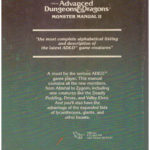Price and stock to confirm
Ed. TSR, 1983. Hard cover. Size 29 x 22,5 cm. State: Used, very well. 160 pages
 An alphabetical listing of monsters found in ADVANCED DUNGEONS & DRAGONS adventures, including attacks, damage, special abilities, descriptions, and random encounter tables.
An alphabetical listing of monsters found in ADVANCED DUNGEONS & DRAGONS adventures, including attacks, damage, special abilities, descriptions, and random encounter tables.
The term «monster» has two different meanings in this work. The first -and more important- meaning is to designate any creature encountered, human, humanoid, or beast, and whether hotile or not. Thus the term is used generically; until the party of adventurers is certain about what they have met, it is a «monster».
The secondary use of the term is the more traditional one -to signify a wicked or horrible creature of some sort. Advanced Dungeons & Dragons players will almost certainly be familiar with these two uses of the word already; those who are newcomers may find them a little confusing at first, but experience will soon determine which of the two uses of the word is appropriate in the particular context.
Each monster is given a full description in the text and values for a number of parameters that collectively describe its behavior, combat mode, etc., in general terms. The parameters are explained below.
NUMBER RANGES are used throughout MONSTER MANUAL II to indicate numbers of creatures appearing, etc.
GENERAL ENTRIES: the figures and facts given under these headings indicate the general status of the monster in question. Then follows a description of the monster in detail -its berhavior, normal habitat, attak/defense styles, special characteristics, and so on. An illustration of a typical creature of the type is included whenever possible.
 FREQUENCY refers to the chance of a creature being encountered in a region or area where it maight live.
FREQUENCY refers to the chance of a creature being encountered in a region or area where it maight live.
NUMBER APPEARING indicates the average numbers player characters might encounter. Generally if a creature is encountered in or near its lair, it can be expected to appear in larger numbers, while further away from its lair it will be encountered in smaller numbers
ARMOR CLASS is a measure of how difficult it is to hit a creature. Armor Class reflects the general type of any protection worn, protection inherent to the creature due to its physical structure or magical nature, or the degree of difficulty in hitting a creature due to its speed, reflexes, etc.
MOVE shows the relative constant speed of the monster. Higher speeds may be possible for short periods. The creature’s movement rate can be scaled to whatever time period is desired by adjusting the ground scale accordingly.
HIT DICE are used to calculate the number of hit points the monster can lose before dying (or, in some cases, before being temporarily banished back to place of origin).
% IN LAIR indicates the chance of the monster being encountered where it lives and stores its treasure (if any).
TREASURE TYPE refers to the treasure table in MONSTER MANUAL I. The table shows the amount and type of treasure along with the probability of whether or not the treasure will contain that amount.
UMBER OF ATTACKS shows the number of physical attacks the monster is able to make during a given melee round.
DAMAGE PER ATTACK indicates the number of hiut points of damage a successfulk attack will cause, expressed as a range of points of damage
 SPECIAL ATTACKS detail such things as dragon breath, magic-use, and so forth
SPECIAL ATTACKS detail such things as dragon breath, magic-use, and so forth
SPECIAL DEFENSES are almost self-explanatory and are detailed in the main text in the same manner as are special attacks
MAGIC RESISTANCE is the chance a spell might fail when cast on the monster; this chance is expressed in a percentage
INTELLIGENCE indicates the basic equivalent of the human intelligence quotient (IQ)
ALIGNMENT indicates the characteristic behavior of the monster toward law, chaos, good or evil, or toward neutrality perhaps modified by good or evil intent
AND MORE…
TABLE OF CONTENTS
Preface
Acknowledgements
How To Use This Book
Monsters from A-Z
Random Encounter Tables
Index
